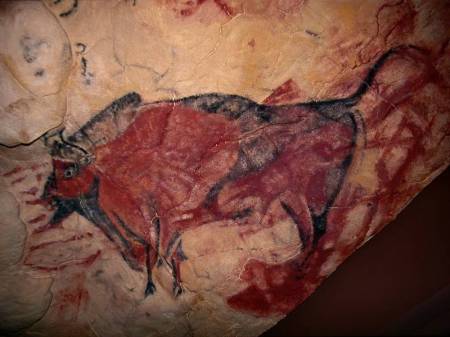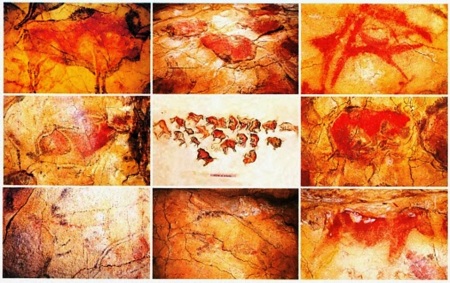
“I visited the Cave of Altamira while traveling in Europe with two friends in 1968. Once inside, I was of course in awe, not only of the age of the paintings, but also of the delicacy and skill with which they had been executed. I think we tend to look down on our distant ancestors as primitive and stupid, but cave paintings like those at Altamira remind us that they were not.” Susan (Washington) – Blogger
On the final morning of our visit to Santillana del Mar the weather proved to be a disappointment, I could hear rain on the window as I started to stir and when I did the weather check I could only report back that the sky was grey and it was drizzling. At breakfast our host confirmed the worst and informed us that the forecast was gloomy all day so we decided that it was probably a good day to go and do something undercover and perhaps visit a museum.
After breakfast we settled up and said goodbye and took the road out of Santillana Del Mar and then followed signposts to the Altamira museum on the edge of the town. I wasn’t expecting a great deal to be honest so was surprised to find a very big car park and a large building built into the hills. I was about to learn about something else that I was completely unaware of – Cantabria is the richest region in the world in archaeological sites from the Upper Paleolithic period (that’s the Stone Age to you and me). The most significant cave painting site is the cave of Altamira, dating from about 16,000 to 9000 BC and declared, with another nine Cantabrian caves, a UNESCO World Heritage Site.
Well, you learn something new every day it seems!

Around 13,000 years ago a rockfall sealed the cave entrance preserving its contents until its eventual discovery which was caused by a nearby tree falling and disturbing the fallen rocks. The really good bit about the story is that it wasn’t discovered by Howard Carter, Tony Robinson or Indiana Jones but by a nine year old girl who came across them while playing in the hills above the town in 1879.
Her father was an amateur archaeologist called Marcelino Sanz de Sautuola and he was led by his daughter to discover the cave’s drawings. The cave was excavated by Sautuola and archaeologist pal Juan Vilanova y Piera from the University of Madrid, resulting in a much acclaimed publication in 1880 which interpreted the paintings as Paleolithic in origin.
So well preserved were the paintings however that there ensued an argument about authenticity and some believed the whole thing to be a hoax and it wasn’t until 1902 that they were eventually accepted as genuine.
In the mellow afternoon we walked tthrough warm wet grass and eucalyptus trees with the sound of oak leaves crisp underfoot. Across a metal walkway and a wooden bridge until we reached a small door that stood resolutely shut. The reason is that only a handful of people each week, selected by lottery, may enter the real caves and nothing else will achieve access.
So we continued to the visitor centre and paid the modest entrance fee of €2.40 and went into the museum, which turned out to be a real treasure with interesting displays about the Stone Age, or the Paleolithic period if you prefer, with the highlight of the visit being a full size recreation of the original cave and its precious paintings.
Today, you see it is only possible to see this copy because the actual cave is now closed to the public. During the 1960s and 1970s, the paintings were being damaged by the damp breath of large numbers of visitors and smoke from Fortuna cigarettes and Altamira was completely closed to the public in 1977, and reopened with only very limited access in 1982.
![altamira[1]](https://apetcher.wordpress.com/wp-content/uploads/2013/01/altamira1.jpg?w=450&h=330)
Very few visitors are allowed in per day, resulting in a three-year waiting list. It would be nice to go into the actual cave but actually the replica allows a more comfortable view of the polychrome paintings of the main hall of the cave, as well as a selection of minor works and also includes some sculptures of human faces that cannot be accessed in the real thing.
And, let me tell you, these people were really good painters. The artists used charcoal and ochre or haematite to create the images, often scratching or diluting these dyes to produce variances in intensity and creating an impression of remarkable and sophisticated contrasts and they also exploited the natural contours in the cave walls to give a three-dimensional effect to their subjects.
The painted ceiling is the most impressive feature showing a herd of bison in different poses, two horses, a large doe and a wild boar. Other images include horses, goats and hand prints created from the artist placing his hand on the cave wall and spraying paint over it leaving a negative image of his palm.
Numerous other caves in northern Spain contain palaeolithic art but none is as advanced or as famous as Altamira.
The entrance to the real cave is not so impressive however…

0.000000
0.000000





![altamira[1]](https://apetcher.wordpress.com/wp-content/uploads/2013/01/altamira1.jpg?w=450&h=330)



![altamira[1]](https://apetcher.wordpress.com/wp-content/uploads/2013/02/altamira1.jpg?w=450&h=318)
